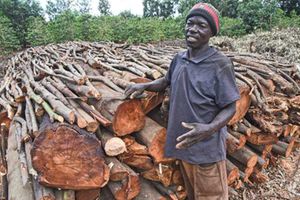Rogue lions still causing a stir after 100 years

The mounted lions displayed at the Field Museum of Natural History in Chicago, USA.
What you need to know:
- The lions remains were sold to the US museum, where they remain a great attraction.
- The movie showed a cave strewn with human bones and skulls, which the engineer had identified it as the lions’ den
For killing 140 people in Kenya, the remains of two lions are crowd pullers at one of the most famous museums in the United States.
They are the mounted skins and skulls of the feared man-eaters of Tsavo that unleashed terror among Indian workers constructing the railway line between Mombasa and Kisumu in the 19th century.
The maneless male lions, which can pass for live animals from afar, are displayed at the renowned Field Museum of Natural History in Chicago.
The big cats’ infamous activities, which lasted nine months in 1898, brought the construction of the important railway line to a temporary stop.
Many visitors
But away from Kenya, where they imprinted their horrendous activities, their remains were sold to the US museum, where they remain a great attraction.
Recently, the display was a hit as Chicago hosted 6,000 journalists at the Unity Journalists of Colour Convention. Although the museum charged $27 (Sh1,800) for entry into the arena, many visitors flocked to the museum’s stand.
Organisers of the conference had also given visitors a taste of the museum when they held a welcome reception for the convention on July 23.
Next to the lions’ remains is a section labelled “Nairobi”, there are pictures of places and personalities including Kenya’s first president Jomo Kenyatta.
Mr Barack Obama - the Democratic presidential candidate, and who has Kenyan roots -held a live interview before the convention on July 27, about two miles away from the museum, enabling people to easily walk to the vicinity soon after.
A minor dispute over the lions’ location arose last year, with Kenya demanding that the remains be returned.
The Kenya National Museum said last year the remains represented an important part of history and heritage hence the need to be returned.
Get them back
“We will use international protocol to repatriate (the lion’s remains)... It would be good to get them back,” National Museum of Kenya spokeswoman Connie Maina told BBC.
The lions were shot by a British engineer, Lt Col John Patterson, who later sold the skulls and hides to the Chicago Field Museum at $5,000 (Sh350,000), a lot of money when the payment was made more than 80 years ago.
In March 1898, during the building of the Kenya-Uganda Railway, Lt Col Patterson had led the construction of a railway bridge over the Tsavo River.
During that period, many Indian railway workers were dragged from their tents at night and devoured by the lions.
Although the men built thorn fences around their camp, they were no match for the man-eaters.
Over 100 workers are said to have lost their lives to the beasts. But Lt Col Patterson set traps and, after many attempts, killed the animals.
Later, the lions’ skins were sold to the museum in 1924 where they were mounted and displayed along with the skulls.
Patterson’s activities were published in his 1907 book, The Man-Eaters of Tsavo. The book was made into a popular movie in 1996, The Ghost and the Darkness. This renewed international interest in the man-eating lions.
The movie showed a cave strewn with human bones and skulls, which the engineer had identified it as the lions’ den. In 1997, scientists from Field Museum identified the cave using his description and photograph of its exterior. But there were no bones.
According to the museum’s Dr Chapurukha Kusimba, originally from Kenya, what the Briton saw matches indigenous Taita community burial customs.
“Among the Taita, a second burial ceremony is carried out six months to two years after the initial burial.
"The skull and, in some cases, long bones are removed and placed in a family ancestral shrine, often on a ledge beneath an overhanging rock or in a rock-shelter or cave. Perhaps Patterson saw such a shrine at the ‘lions’ den’,” said Dr Kusimba.




